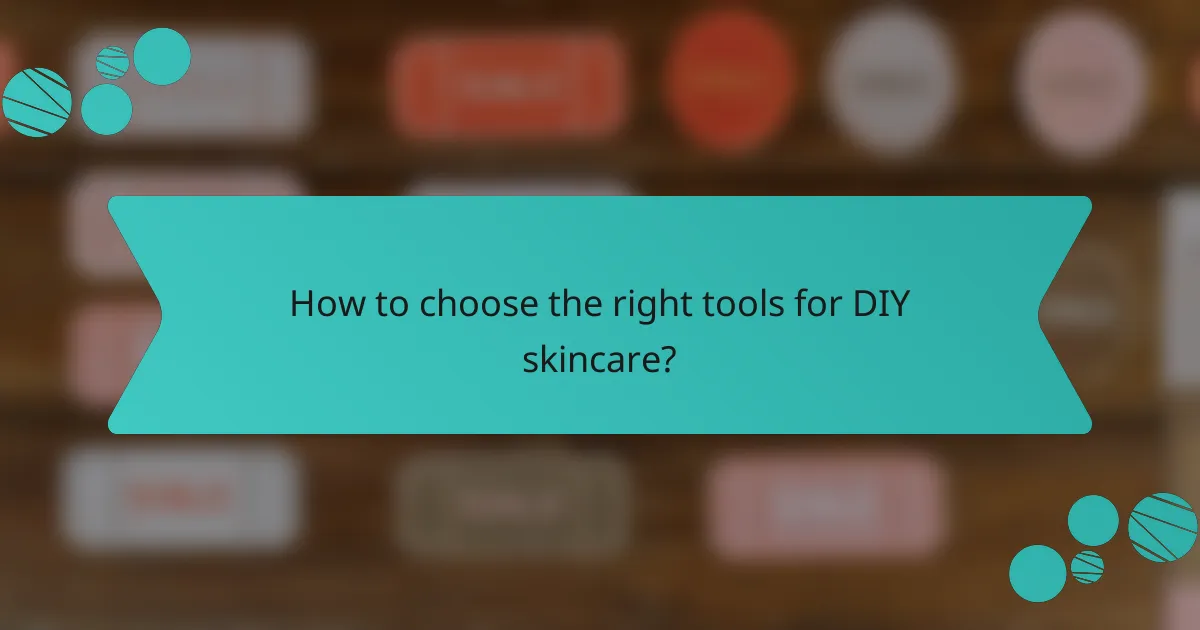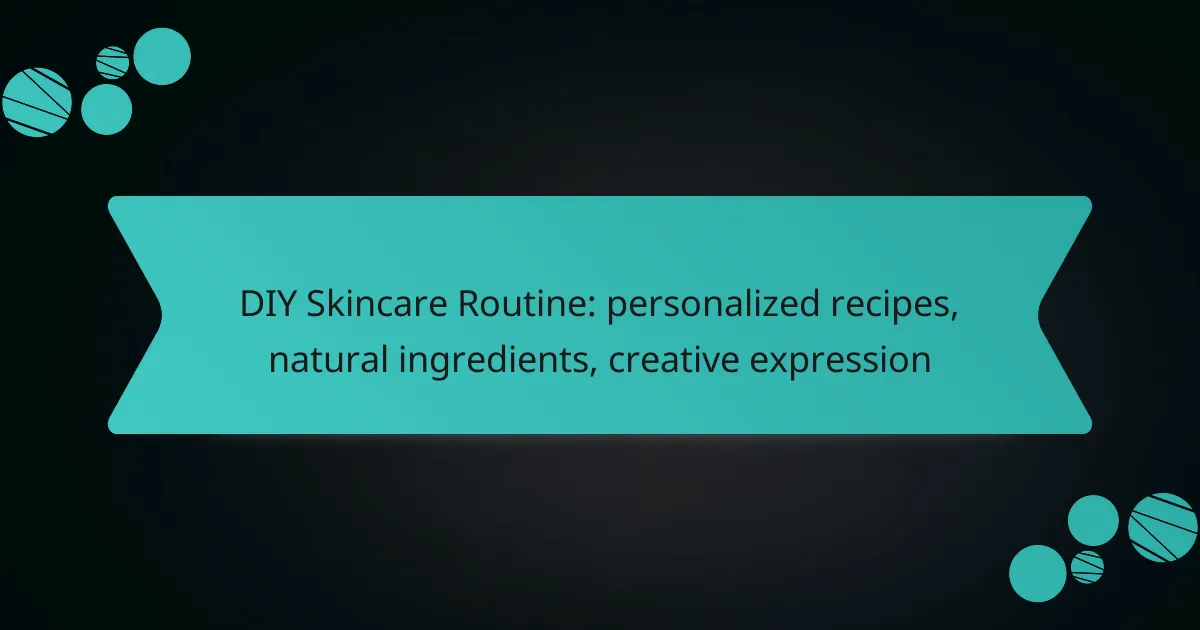Crafting a DIY skincare routine allows you to tailor your regimen to your unique skin needs while embracing the use of natural ingredients. By incorporating elements like coconut oil, aloe vera, and honey, you can enhance your skin’s health and express your creativity through personalized recipes. Understanding your skin type and concerns is key to developing effective formulations that nourish and rejuvenate.

How to create a DIY skincare routine in the UK?
Creating a DIY skincare routine in the UK involves understanding your skin’s needs and selecting natural ingredients that suit those needs. By establishing a consistent regimen, you can effectively enhance your skin’s health while expressing your creativity.
Identify your skin type
Determining your skin type is crucial for a personalized skincare routine. Common skin types include oily, dry, combination, and sensitive. You can identify your skin type by observing how your skin feels throughout the day; for example, oily skin may appear shiny, while dry skin may feel tight or flaky.
To assess your skin, wash your face and wait for an hour without applying any products. Then, evaluate how your skin reacts. This simple test can help you choose the right ingredients and products for your routine.
Select suitable natural ingredients
Choosing the right natural ingredients is essential for effective skincare. For oily skin, consider ingredients like tea tree oil or witch hazel, which can help control excess oil. For dry skin, opt for nourishing oils such as jojoba or almond oil, which provide hydration and moisture.
Research common natural ingredients and their benefits. For example, aloe vera is soothing for sensitive skin, while honey has antibacterial properties. Always perform a patch test before using new ingredients to avoid adverse reactions.
Establish a daily regimen
A daily skincare regimen should include cleansing, toning, and moisturizing. Start with a gentle cleanser to remove impurities, followed by a toner to balance your skin’s pH. Finally, apply a moisturizer suitable for your skin type to lock in hydration.
Consider incorporating treatments like exfoliation or masks a few times a week. Keep your routine simple and consistent, adjusting products as needed based on how your skin responds. Aim for a routine that takes no more than 10-15 minutes each day to ensure you stick with it.

What are the best natural ingredients for skincare?
The best natural ingredients for skincare include coconut oil, aloe vera, and honey. These ingredients are known for their unique properties that can enhance skin health, offering hydration, soothing effects, and antibacterial benefits.
Coconut oil for hydration
Coconut oil is an excellent natural moisturizer that helps to hydrate the skin effectively. It contains fatty acids that penetrate the skin barrier, providing deep hydration and preventing moisture loss.
When using coconut oil, apply a small amount to clean skin, focusing on dry areas. It can be used alone or mixed with essential oils for added benefits. However, those with oily or acne-prone skin should use it sparingly, as it may clog pores.
Aloe vera for soothing
Aloe vera is renowned for its soothing properties, making it ideal for calming irritated or sunburned skin. Its gel-like consistency allows for easy application and absorption, providing instant relief.
To use aloe vera, apply fresh gel directly from the leaf or use a store-bought product with a high concentration of aloe. It’s beneficial for all skin types, but always perform a patch test to ensure there are no allergic reactions.
Honey for antibacterial properties
Honey is a natural antibacterial agent that can help prevent acne and promote healing. Its high viscosity allows it to draw moisture into the skin while also providing a protective barrier.
For skincare, apply raw honey directly to the skin as a mask, leaving it on for about 20 minutes before rinsing. Avoid using honey on open wounds, and opt for organic varieties to ensure purity and effectiveness.

How to personalize your skincare recipes?
Personalizing your skincare recipes involves selecting ingredients that cater to your specific skin type and concerns. By understanding your skin’s needs and experimenting with various natural components, you can create effective and unique formulations.
Mixing essential oils
Essential oils can enhance the benefits of your skincare recipes by adding therapeutic properties and pleasant fragrances. Choose oils that align with your skin type; for example, tea tree oil is great for acne-prone skin, while lavender is soothing for sensitive skin.
When mixing essential oils, use a carrier oil to dilute them, as they can be potent. A common ratio is 1-2 drops of essential oil per teaspoon of carrier oil. Always perform a patch test to avoid adverse reactions.
Adjusting ingredient ratios
Adjusting ingredient ratios is crucial for tailoring your skincare products to your preferences and skin needs. For instance, if your skin feels oily, you might reduce the amount of oil in your recipe while increasing hydrating ingredients like aloe vera.
Start with standard recipes and modify them gradually. A good rule of thumb is to change one ingredient at a time, allowing you to observe the effects before making further adjustments. Keep notes on your changes for future reference.
Incorporating seasonal ingredients
Incorporating seasonal ingredients can enhance the freshness and effectiveness of your skincare recipes. For example, in summer, you might use cooling cucumber and hydrating watermelon, while in winter, richer ingredients like shea butter and coconut oil can provide necessary moisture.
Consider local markets for fresh, seasonal produce that can be easily integrated into your skincare routine. This not only supports local agriculture but also ensures that your ingredients are at their peak nutritional value.

What are the benefits of DIY skincare?
DIY skincare offers numerous advantages, including cost savings, tailored solutions for individual skin types, and the ability to use organic ingredients. By creating your own products, you can control what goes on your skin and ensure it meets your specific needs.
Cost-effective solutions
Making your own skincare products can significantly reduce costs compared to purchasing commercial brands. Basic ingredients like oils, butters, and essential oils are often available at reasonable prices, allowing you to create multiple products for a fraction of the cost.
For example, a homemade face mask can be made for just a few dollars, while similar store-bought options may cost ten times that amount. Bulk buying of ingredients can further enhance savings, making DIY skincare an economical choice.
Customization for specific needs
DIY skincare allows you to customize products based on your unique skin type and concerns. Whether you have dry, oily, or sensitive skin, you can select ingredients that specifically address your issues, such as using aloe vera for hydration or tea tree oil for acne.
Consider keeping a journal of your skin’s reactions to different ingredients. This will help you refine your recipes and create effective products tailored to your needs, ensuring optimal results.
Use of organic ingredients
Creating your own skincare products gives you the freedom to choose organic ingredients, which can be gentler on the skin and the environment. Many commercial products contain synthetic additives and preservatives that may irritate sensitive skin.
When selecting organic ingredients, look for certifications to ensure quality. Common organic options include coconut oil, shea butter, and essential oils, which can enhance the effectiveness of your skincare routine while promoting sustainability.

How to choose the right tools for DIY skincare?
Selecting the right tools for DIY skincare is crucial for achieving effective and safe results. Consider functionality, material safety, and ease of cleaning when choosing your tools.
Essential mixing tools
For mixing your skincare ingredients, basic tools include bowls, spatulas, and whisks. Opt for glass or stainless steel bowls, as they are non-reactive and easy to clean.
A digital scale can help you measure ingredients accurately, ensuring consistent results. If you’re working with small quantities, consider using measuring spoons or cups.
Storage options for homemade products
Proper storage is essential to maintain the quality of your homemade skincare products. Use dark glass containers to protect sensitive ingredients from light exposure.
Label your containers with the product name and date of creation to keep track of freshness. Most homemade skincare products should be used within a few weeks to a few months, depending on the ingredients.
Safety equipment for ingredient handling
When handling skincare ingredients, prioritize safety by using gloves and goggles, especially if you are working with potent substances like essential oils or preservatives. This minimizes skin irritation and protects your eyes.
Always work in a clean environment and sanitize your tools before use to prevent contamination. Consider wearing a mask if you’re sensitive to strong scents or powders.

What are common mistakes in DIY skincare?
Common mistakes in DIY skincare often stem from a lack of understanding of ingredients and skin types. Many individuals overlook skin sensitivities, misuse essential oils, or fail to follow proper hygiene practices, which can lead to irritation or adverse reactions.
Ignoring skin sensitivities
Ignoring skin sensitivities is a prevalent mistake in DIY skincare that can result in irritation or allergic reactions. Each person’s skin has unique characteristics and may react differently to various natural ingredients, such as essential oils or plant extracts.
To avoid this pitfall, conduct a patch test before applying any new product to your face. Apply a small amount of the mixture to an inconspicuous area, like the inside of your wrist, and wait 24 hours to see if any adverse reactions occur.
Additionally, familiarize yourself with common allergens and irritants. Ingredients like citrus oils, fragrances, and certain botanical extracts can trigger sensitivities in some individuals. Always prioritize gentle, hypoallergenic options, especially if you have a history of skin issues.
